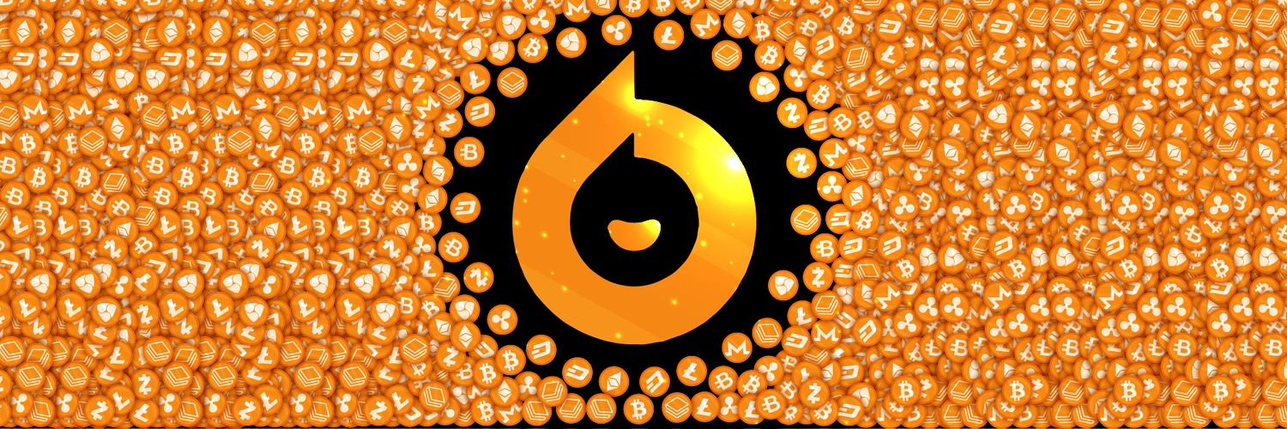Bitget: #4 al mondo per volume di trading giornaliero!
Quota di mercato di BTC62.51%
Nuovi listing su Bitget : Pi Network
BTC/USDT$84769.69 (+1.39%)Indice Paura & Avidità45(Neutrale)
Indice Altcoin Season:0(Stagione di Bitcoin)
Monete listate nel Pre-MarketPAWS,WCTFlusso netto totale di ETF Spot su Bitcoin -$1M (1G); -$872.6M (7G).Pacchetto regalo di benvenuto per i nuovi utenti del valore di 6.200 USDT.Riscatta
Fai trading sempre e ovunque con l'app Bitget. Scarica ora
Bitget: #4 al mondo per volume di trading giornaliero!
Quota di mercato di BTC62.51%
Nuovi listing su Bitget : Pi Network
BTC/USDT$84769.69 (+1.39%)Indice Paura & Avidità45(Neutrale)
Indice Altcoin Season:0(Stagione di Bitcoin)
Monete listate nel Pre-MarketPAWS,WCTFlusso netto totale di ETF Spot su Bitcoin -$1M (1G); -$872.6M (7G).Pacchetto regalo di benvenuto per i nuovi utenti del valore di 6.200 USDT.Riscatta
Fai trading sempre e ovunque con l'app Bitget. Scarica ora
Bitget: #4 al mondo per volume di trading giornaliero!
Quota di mercato di BTC62.51%
Nuovi listing su Bitget : Pi Network
BTC/USDT$84769.69 (+1.39%)Indice Paura & Avidità45(Neutrale)
Indice Altcoin Season:0(Stagione di Bitcoin)
Monete listate nel Pre-MarketPAWS,WCTFlusso netto totale di ETF Spot su Bitcoin -$1M (1G); -$872.6M (7G).Pacchetto regalo di benvenuto per i nuovi utenti del valore di 6.200 USDT.Riscatta
Fai trading sempre e ovunque con l'app Bitget. Scarica ora



Prezzo di MajorMAJOR
Listato
Valuta di quotazione:
EUR
€0.1097-0.53%1D
Convertitore da MAJOR a EUR
MAJOR
EUR
1 MAJOR = 0.00 EUR
Bitget offre le commissioni di transazione più basse tra tutte le principali piattaforme di trading. Più alto è il tuo livello VIP, più i tassi sono vantaggiosi.
Prezzo
TradingView
Capitalizzazione di mercato
Grafico dei prezzi di Major (MAJOR/EUR)
Ultimo aggiornamento il 2025-04-13 07:20:21(UTC+0)
Capitalizzazione di mercato:€9,144,519.62
Capitalizzazione di mercato completamente diluita:€9,144,519.62
Volume (24h):€18,700,415.1
Volume 24h / Cap. di mercato:204.49%
Massimo di 24h:€0.1159
Minimo di 24h:€0.1089
Massimo storico:€32.34
Minimo storico:€0.08740
Offerta circolante:83,349,870 MAJOR
Offerta totale:
99,999,999MAJOR
Tasso di circolazione:83.00%
Offerta massima:
99,999,999MAJOR
Prezzo in BTC:0.{5}1472 BTC
Prezzo in ETH:0.{4}7701 ETH
Prezzo con la capitalizzazione di mercato di BTC:
€17,751.9
Prezzo con capitalizzazione di mercato di ETH:
€2,062.89
Contratti:
EQCuPm...U_MAJOR(TON)
Altro
Come ti senti oggi in merito a Major?
Nota: queste informazioni sono solo di riferimento.
Prezzo di Major di oggi in EUR
Il prezzo di Major in tempo reale è di €0.1097 EUR oggi, con una capitalizzazione di mercato attuale di €9.14M. Il prezzo di Major è sceso di 0.53% nelle ultime 24 ore e il volume di trading nelle 24 ore è €18.70M. Il tasso di conversione MAJOR/EUR (da Major a EUR) viene aggiornato in tempo reale.
Storico dei prezzi di Major (EUR)
Il prezzo di Major è variato di un -91.14% nell’ultimo anno. Il prezzo più alto di MAJORNEW in EUR nell’ultimo anno è stato €32.34, mentre il prezzo più basso di MAJORNEW in EUR nell’ultimo anno è stato €0.08740.
DataVariazione del prezzo (%) Prezzo più basso
Prezzo più basso Prezzo più alto
Prezzo più alto 
 Prezzo più basso
Prezzo più basso Prezzo più alto
Prezzo più alto 
24h-0.53%€0.1089€0.1159
7d-6.16%€0.1004€0.1161
30d+4.30%€0.1004€0.2255
90d-71.02%€0.08740€0.4041
1y-91.14%€0.08740€32.34
Tutto il periodo-90.88%€0.08740(2025-03-11, 33 giorni fa )€32.34(2024-11-27, 137 giorni fa )
Qual è il prezzo più alto di Major?
Il prezzo massimo storico (ATH) di Major in EUR è stato di €32.34, registrato in data 2024-11-27. Rispetto all’ATH di Major, il prezzo attuale di Major è sceso di 99.66%.
Qual è il prezzo più basso di Major?
Il prezzo minimo storico (ATL) di Major in EUR è stato di €0.08740, registrato in data 2025-03-11. Rispetto all’ATL di Major, il prezzo attuale di Major è salito di 25.54%.
Previsione del prezzo di Major
Quando è il momento giusto per acquistare MAJOR? Dovrei acquistare o vendere MAJOR ora?
Quando decidi se acquistare o vendere MAJOR, devi innanzitutto considerare la tua strategia di trading. L'attività di trading tra i trader a lungo e a breve termine sarà diversa. L'Analisi tecnica di MAJOR di Bitget può fornire un riferimento per il trading.
Secondo l'Analisi tecnica di MAJOR (4h), il segnale di trading è Vendi.
Secondo l'Analisi tecnica di MAJOR (1d), il segnale di trading è Vendi adesso.
Secondo l'Analisi tecnica di MAJOR (1w), il segnale di trading è Vendi.
Quale sarà il prezzo di MAJOR nel 2026?
In base al modello di previsione della performance storica del prezzo di MAJOR, si prevede che il prezzo di MAJOR raggiungerà quota €0.1597 nel 2026.
Quale sarà il prezzo di MAJOR nel 2031?
Nel 2031, il prezzo di MAJOR dovrebbe aumentare del -1.00%. Entro la fine del 2031, si prevede che il prezzo di MAJOR raggiunga quota €0.4220, con un ROI cumulativo del +284.19%.
FAQ
Qual è il prezzo attuale di Major?
Il prezzo in tempo reale di Major è €0.11 per (MAJOR/EUR), con una capitalizzazione di mercato attuale di €9,144,519.62 EUR. Il valore di Major è soggetto a frequenti fluttuazioni a causa dell’attività continua, 24 ore su 24 e 7 giorni su 7, del mercato crypto. Il prezzo attuale di Major in tempo reale e i suoi dati storici sono disponibili su Bitget.
Qual è il volume di trading di 24 ore di Major?
Nelle ultime 24 ore, il volume di trading di Major è €18.70M.
Qual è il massimo storico di Major?
Il massimo storico di Major è €32.34. Questo massimo storico è il prezzo più alto di Major da quando è stato lanciato.
Posso acquistare Major su Bitget?
Sì, Major è attualmente disponibile sull’exchange centralizzato di Bitget. Per altre informazioni dettagliate, consulta la guida su Come acquistare major .
Posso ottenere un guadagno costante investendo in Major?
Ovviamente Bitget fornisce un piattaforma di trading strategico, con trading bot intelligenti per automatizzare le operazioni e ottenere dei profitti.
Dove posso acquistare Major con la commissione più bassa?
Siamo entusiasti di annunciare che la piattaforma di trading strategico è ora disponibile sull’exchange di Bitget. Bitget offre delle commissioni di trading e una profondità tra le migliori del settore per garantire ai trader investimenti redditizi.
Notizie su Major
Vedi di più
Aggiornamenti su Major
Saldo di Major per concentrazione
Whale
Investitori
Retail
Indirizzi Major per durata dell'holding
Holder
Cruiser
Trader
Grafico del prezzo di coinInfo.name (12) in tempo reale

Prezzi di Major globali
Quanto vale Major in altre valute? Ultimo aggiornamento: 2025-04-13 07:20:21(UTC+0)
MAJOR a MXN
Mexican Peso
$2.53MAJOR a GTQGuatemalan Quetzal
Q0.96MAJOR a CLPChilean Peso
$122.8MAJOR a HNLHonduran Lempira
L3.22MAJOR a UGXUgandan Shilling
Sh457.09MAJOR a ZARSouth African Rand
R2.38MAJOR a TNDTunisian Dinar
د.ت0.37MAJOR a IQDIraqi Dinar
ع.د162.94MAJOR a TWDNew Taiwan Dollar
NT$4.03MAJOR a RSDSerbian Dinar
дин.12.86MAJOR a DOPDominican Peso
$7.66MAJOR a MYRMalaysian Ringgit
RM0.55MAJOR a GELGeorgian Lari
₾0.34MAJOR a UYUUruguayan Peso
$5.4MAJOR a MADMoroccan Dirham
د.م.1.16MAJOR a AZNAzerbaijani Manat
₼0.21MAJOR a OMROmani Rial
ر.ع.0.05MAJOR a KESKenyan Shilling
Sh16.11MAJOR a SEKSwedish Krona
kr1.22MAJOR a UAHUkrainian Hryvnia
₴5.15- 1
- 2
- 3
- 4
- 5
Come acquistare Major(MAJOR)

Crea il Tuo Conto Bitget Gratuito
Registrati su Bitget con il tuo indirizzo e-mail/numero di cellulare e crea una password forte per proteggere il tuo conto.

Verifica il Tuo Conto
Verifica la tua identità inserendo i tuoi dati personali e caricando un documento d'identità valido con foto.

Converti Major in MAJOR
Scegli tra le criptovalute da scambiare su Bitget.
Scopri di piùFai trading sui futures perpetui MAJOR
Dopo essersi registrati con successo su Bitget e aver acquistato i token USDT o MAJOR, puoi iniziare a fare trading sui derivati, compresi i futures MAJOR e il trading con margine, per aumentare i tuoi rendimenti.
Il prezzo attuale di MAJOR è €0.1097, con una variazione di prezzo in 24 ore di -0.53%. I trader possono trarre profitto sia andando long che short sui futures MAJOR.
Partecipa al copy trading di MAJOR seguendo i trader d’élite.
Una volta creato un account Bitget e aver acquistato dei token USDT o MAJOR puoi iniziare a fare copy trading seguendo i trader d’élite.
Nuovi listing su Bitget
Nuovi listing
Acquista di più
Dove posso acquistare Major (MAJOR)?
Acquista crypto sull'app Bitget
Iscriviti in pochi minuti per acquistare crypto con carta di credito o bonifico bancario.
Sezione video: verifica rapida e accesso rapido al trading

Come completare la verifica dell’identità su Bitget e proteggersi dalle frodi
1. Accedi al tuo account Bitget.
2. Se sei nuovo/a su Bitget, guarda il nostro tutorial su come creare un account.
3. Passa sull’icona del tuo profilo, clicca su “Non verificato” e quindi su “Verifica”.
4. Scegli il Paese o il territorio di emissione del tuo documento d’identità e il tipo di documento e segui le istruzioni.
5. Seleziona “Verifica mobile” o “Verifica PC” in base alle tue preferenze.
6. Inserisci i tuoi dati, invia una copia del tuo documento d’identità e scatta un selfie.
7. Invia la tua richiesta ed è fatta: hai completato la verifica dell’identità!
Gli investimenti in criptovalute, incluso l’acquisto di Major online tramite Bitget, sono soggetti a rischio di mercato. Bitget ti fornisce modalità facili e pratiche per acquistare Major. Ci impegniamo al massimo per informare gli utenti sulle criptovalute presenti sull’exchange. Ad ogni modo, non siamo responsabili per le conseguenze che si potrebbero verificare a seguito dell’acquisto di Major. Questa pagine e le informazioni presenti non rappresentano un consiglio a investire su una determinata criptovaluta.
Convertitore da MAJOR a EUR
MAJOR
EUR
1 MAJOR = 0.1097 EUR
Bitget offre le commissioni di transazione più basse tra tutte le principali piattaforme di trading. Più alto è il tuo livello VIP, più i tassi sono vantaggiosi.
Valutazioni di Major
Valutazioni medie della community
4.2
Questo contenuto è a puro scopo informativo.
Bitget Insights

Bpay-News
3h
Alchemy Pay releases 2025 roadmap: Alchemy Chain will become a stablecoin public chain and plans to launch AI payment products
Alchemy Pay, a cryptocurrency payment solutions provider, released its 2025 strategic roadmap, announcing its transformation from a crypto payment gateway to a global financial center, mainly including: 1. The regulation-first growth model is accelerating in South Korea, Australia and other regions, and plans to expand wallets, public chains and DEX partners to the ecosystem; 2. In the transformation from a payment gateway to a global financial center supporting risk-weighted assets, Alchemy Pay will no longer be limited to the positioning of a payment platform. In the future, it will cooperate and integrate with RWA service providers to promote RWA investment; 3. Alchemy Chain will develop into a public blockchain built around stablecoins, aggregating the liquidity and utility of major global and local stablecoins such as USDT and USDC in different blockchain networks; 4. Artificial intelligence encrypted payments, an AI payment product is in the works, with the goal of becoming the standard payment infrastructure for the AI Agent ecosystem.
MAJOR-3.18%
USDC0.00%

INVESTERCLUB
4h
Cryptocurrency Market Surges Following U.S. Tariff Exemption Policy
U.S. President Donald Trump's recent tariff exemption policy over the weekend has led to a significant surge in the cryptocurrency market. Bitcoin reached a high of $85,900, overcoming resistance around $83,000, as the technology sector's burden from high import costs eased considerably compared to 24 hours earlier.
Historically, cryptocurrencies like Bitcoin tend to move in tandem with tech stocks, especially when investor sentiment shifts towards riskier assets. Trump's tariff exemption policy has lifted the cloud over the tech industry, indirectly alleviating pressure on the crypto market. Within hours of the announcement, Bitcoin rebounded to its weekend peak.
The exemption of tariffs on semiconductors and computer components is seen as a long-term benefit for the crypto ecosystem. These components are crucial for cryptocurrency mining, blockchain infrastructure, and AI-based crypto tool development.
Continuous and affordable production and supply of these parts ensure the smooth operation of the crypto industry, including exchanges, wallet providers, and tech startups focused on blockchain solutions.
Despite the complexity and unpredictability of Trump's trade policies, the targeted exemption for tech equipment provides clear short-term policy direction and eases market pressure. Investors are now more confident that inflation in consumer electronics will be avoided, and companies won't be forced to raise prices or cut innovation. While this doesn't signal the end of tariff concerns, it does alleviate one of the major worries facing the cryptocurrency sector.
The crypto market has shown a moderate bullish response, and the stock market is expected to rise on Monday, further boosting Bitcoin and altcoins. However, after the initial reaction, the market dynamics will become more intriguing, and widespread 'FOMO' sentiment could stifle any upward trend.
MOVE-4.10%
BITCOIN-5.72%

Bpay-News
4h
BlackRock CEO: Economic recession may have begun, but the release of new liquidity may become a catalyst for cryptocurrencies
In an interview with CNBC, BlackRock CEO Larry Fink sounded the alarm about a possible recession in the United States, warning that a recession may have already begun. Larry Fink pointed to rising economic pressures and protectionist trade policies as key drivers behind what he sees as a slow economic contraction. While fears of a recession typically rattle traditional markets, cryptocurrency investors may have reason to be excited. The coming economic slowdown could prompt the Federal Reserve to reverse its monetary tightening policies, potentially unleashing a new wave of liquidity. According to analysts, this scenario could serve as a major catalyst for digital assets such as Bitcoin. Larry Fink's comments are in line with similar predictions from major Wall Street institutions such as JPMorgan Chase, Deutsche Bank and Goldman Sachs. On decentralized prediction markets such as Kalshi and PolyMarket, traders are also increasingly betting that a U.S. recession is imminent. (Cryptodnes)
MAJOR-3.18%
S-1.86%

PappyVanCrypto
4h
Good question. Yes. The $72k lower low had to be tagged this week. If it doesn’t happen within 24 hours (very unlikely) then the lows are in. We will make higher highs moving forward imo. April 14 is a major pivot as I mentioned previously. Although I expect a pullback from here we have reclaimed the 3 year trendline after a 3 day fake out below it. The trendline is now sitting at 81.8k. I’ll be looking for longs in that area… $btc
BTC-0.58%
MAJOR-3.18%

TradingHeights
6h
Zcash: Your Altcoin Choice for the 2025 Supercycle
Potential Growth: 1,476% to 3,627%
Zcash ( $zec ) continues to stand out — not just because of its legacy, but because of its current structure and massive upside potential.
Following a request from one of our long-term followers, we’ve taken a deep dive into the chart. And the signals are clear:
ZEC is ready for the next big move.
Bull Market Comparison: Then vs. Now
🔹 March 2020 Bottom ➝ 2021 Peak: +2,067%
🔹 June 2024 Bottom ➝ Projected 2025 ATH: +3,627% (total cycle)
🔹 From current price: Up to 1,476% potential upside
And this is all based on standard bull market behavior. If this cycle extends into a super bull, the upside could become truly exponential.
Why the Recent "Flushes" Are Bullish
In late 2024 and again in February 2025, ZEC saw sharp pullbacks or “flushes.” And another one just occurred this week — but with a strong bullish reaction:
🔹 Long lower wick = buyers stepped in
🔹 Price is now trading green
🔹 If the week closes bullish, it confirms a strong higher low
This setup opens the door for a higher high, which is exactly what bull markets are built on.
Key Price Targets
Here’s what we’re watching in terms of price movement:
🔹 First target: $151
🔹 Mid-cycle target: $235
🔹 Full-cycle ATH potential (2025): +3,627% from June 2024 low
And again — these are based on typical cycle behavior. ZEC can go much further if macro conditions align.
Why This Cycle Looks Better Than 2021
This time, the setup is cleaner and the structure is stronger:
🔹 Flushes cleared out weak hands
🔹 Higher low confirms bullish strength
🔹 The broader crypto market is turning bullish across the board
ZEC is no longer just a privacy coin — it’s a legacy altcoin with fresh potential, primed for the next wave of institutional and retail capital.
Are You Planning for What's Coming?
With just weeks before the next major impulse wave, now is the time to prepare:
🔹 How will you take profits?
🔹 Will you sell in waves?
🔹 Will you rebuy dips?
🔹 What’s your exit plan?
🔹 How long can you wait if the market pulls back again?
These aren’t questions for later. These are questions for now.
Final Thoughts: Only Weeks Left
Zcash is:
🔹 Technically strong
🔹 Bullish on multiple timeframes
🔹 Poised for a potential All-Time High in 2025
The time to buy is not when the market is green — it’s when the setup is red but loaded.
And ZEC is exactly that.
Start preparing now. The bull market isn’t coming — it’s arriving.
Thanks for reading.
Your support is always appreciated — and your timing is excellent.
RED-4.41%
MOVE-4.10%
Asset correlati
Criptovalute popolari
Una selezione delle 8 crypto con il più alto market cap.
Aggiunte di recente
Le criptovalute aggiunte più di recente.
Informazioni aggiuntive su Major
Panoramica della moneta
In relazione alle monete
In relazione al trading
Aggiornamenti delle monete
Trading
Earn
MAJOR non è disponibile per il trading sull’Exchange Bitget, e può essere custodito sul Bitget Wallet. L’ è anche uno dei primi CEX a supportare gli scambi su MAJOR.
Puoi fare trading di MAJOR su Bitget.MAJOR/USDT
SpotMAJOR/USDT
Futures USDT-M























.png)






